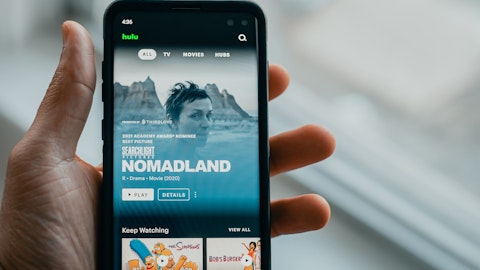Comcast Corporation (NASDAQ:CMCSA) Q2 2023 Earnings Call Transcript July 27, 2023
Comcast Corporation beats earnings expectations. Reported EPS is $1.01, expectations were $0.97.
Operator: Good morning, ladies and gentlemen, and welcome to Comcast’s Second Quarter Earnings Conference Call. At this time all participants are in a listen-only mode. Please note that this conference call is being recorded. I will now turn the call over to Executive Vice President, Investor Relations, Ms. Marci Ryvicker. Please go ahead, Ms. Ryvicker.
Marci Ryvicker: Thank you, operator, and welcome to our second quarter 2023 earnings call. You’ll first hear from Mike Cavanagh and Jason Armstrong. Then Brian Roberts and Dave Watson will join us and be available for Q&A. I will now refer you to slide two of the presentation accompanying this call, which can also be found on our Investor Relations Web site, which contains our Safe Harbor disclaimer. This conference call may include forward-looking statements subject to certain risks and uncertainties. In addition, during this call, we will refer to certain non-GAAP financial measures. Please see our 8-K and trending schedule issued earlier this morning for the reconciliations of these non-GAAP financial measures to GAAP. With that, I’ll turn the call over to Mike.
Michael Cavanagh: Thanks, Marci, and good morning, everyone. I’m very pleased with our second quarter results, which again demonstrate that our focused efforts to invest and innovate in businesses that offer significant revenue growth, while we carefully manage the contiguous areas with structurally lower growth is paying off. Total revenue grew 2%, and the sixth growth priority areas we have outlined: residential broadband, wireless, business services, theme parks, streaming and premium content creation in our studios, grew nearly 10% year-over-year, and now represent 55% of total revenue. This revenue growth combined with careful management of margins across all businesses generated mid single-digit EBITDA growth and double-digit earnings per share growth.
Looking farther into the future, we expect to continue to drive significant growth in these areas, and to continue to identify and invest in organic growth opportunities across our strong portfolio of businesses. We are also very clear-eyed about the challenges that we and our competitors face in other business lines, and have established thoughtful plans which will enable these businesses to continue to meaningfully contribute both financially and strategically. Importantly, the net effect of this approach is a path to sustained future revenue growth for the company in total, driving strong earnings and free cash flow growth for, what I expect to be, many years to come. Significantly, we have by far the strongest balance sheet among our core competitors, which allows us to continue to invest for growth while returning substantial capital to shareholders through both dividends and buybacks which will drive excellent free cash flow and earnings per share growth.
Now, let me call out a few highlights from the quarter. For the first time in the company’s history, we generated over $10 billion in quarterly EBITDA. And while the diversification of our businesses means there were several significant contributors, I would highlight three that stand out to me in the quarter and reflect the consistency of our investments and the resulting durability of our growth profile. The first is broadband ARPU growth of 4.5%. Stepping back, I am confident we have a winning hand in convergence. We are the largest broadband provider with a high-quality ubiquitous network, and the most cost-efficient upgrade path to higher speeds. In addition, we can compete effectively in wireless with a capital-light approach, and a very strong value proposition for our customers.
We also have a long history of consistently surrounding our products with industry-leading features and capabilities, ranging from the coverage and control aspects of our WiFi experience, to content aggregation through our X1 and Flex platforms, which is how we have been able to achieve near-record low levels of churn and grow ARPU consistently quarter after quarter. This second quarter’s 4.5% growth was no exception, and is a testament to our ability to appropriately balance rate and volume to effectively segment the market and surround our broadband product with industry-leading products and capabilities. The broadband market remains highly competitive, but we have and will continue to invest to sustain our position as a market leader. Second is our parks, which continues to be such a great story for us.
Our teams have consistently introduced new and innovative attractions, leveraging both our owned or licensed IP. We opened Super Nintendo World at both Universal Hollywood and Japan, which helped drive the record results in the quarter. Later this summer, we will be opening a new Minion Land in Orlando, and we look forward to Donkey Kong, in Japan, next year, as well as starting the previously announced kid’s theme park, in Texas, and the Halloween Horror experience, in Las Vegas. And I couldn’t be more excited about the opening of Epic Universe, in Orlando, in 2025. Third is the strength of our film studios and in particular our animation business. Super Mario Bros. crossed over $1.3 billion in worldwide box office to date, making it the second-highest grossing animated film ever.
This is another incredible achievement by Illumination and Chris Meledandri. We also invest in successful franchises like Fast, highlighted by the successful launch of the latest installment with Fast X during the quarter. Of course, we just released Oppenheimer, which gross about $180 million this past weekend to tremendous acclaim from critics and moviegoers alike. Oppenheimer is such a powerful and impactful movie, and we at Comcast couldn’t be proud to work with Christopher Nolan to bring such an important movie to audiences globally. We have the very best roster of creative partners, and these innovative filmmakers enable us to invest in a strategic slate, which is one of the keys to our continued box office success where we remain number two in box office year-to-date.
All of these results and accomplishments, from broadband differentiation, to studio leadership, to our park success are a function of our focused leadership team, commitment to innovation, strong balance sheet, and disciplined approach to capital allocation. As I look at our company, I am extremely bullish on the durability of growth drivers we have invested in so consistently, and in our continued ability to invest and deliver through a variety of businesses and economic cycles. This was also my first quarter with direct responsibility for NBCUniversal. And I observed in a note announcing some organizational changes a few weeks ago, NBCU is a very special place with tremendous opportunities ahead. I could not be more impressed with the depth of talent, and particularly with our leadership team.
And I am very confident that the new streamlined organization we have just put in place, and which has been very well received will help us move even faster and make even better decisions. As you know, NBCU operates a diverse array of businesses, each with leading market positions. In addition to film and parks, which I referenced earlier, we have the number one TV portfolio by total audience, and our TV studio is award-winning and prolific. We’re the number one most watched news organization in the U.S., and sports continues to be a huge driver, with the NFL, NASCAR, gold, Premier League, the World Cup on Telemundo, including the Women’s World Cup going on right now, Big Ten starting this fall, and the Paris Olympics coming up next year. I am also confident that we have the right strategy for the future.
We produce premium content through our studios, distributed through our TV networks, Peacock and third parties, and further monetize this content with our theme parks and consumer products. In streaming, we launched Peacock as an ad-supported model that is an extension of our existing business. We set out a plan, which we have adapted as needed, and Peacock is strong and growing. We gained two million paid subscribers in the second quarter, going from 22 million to 24 million paid subscribers. This growth was largely driven by conversion of Comcast subs to paying relationships which started in June. And we’re very pleased with the results so far. Without a doubt, consumer trends such as cord-cutting and new competitors, particularly from the technology sector present challenges for us.
And we are facing an uncertain macro environment which continues to pressure linear advertising. But I firmly believe that we have the business strategy, management dept, and financial strength to emerge as long-term winners and value creators as the landscape evolves at NBCUniversal, and across the company. Another challenge in the near-term are the writers and actors strikes. We remain committed to reaching a fair deal as soon as possible so we can get back to doing what we do best, which is making great content together. With that, let me turn it over to Jason.
Jason Armstrong: Thanks, Mike, and good morning, everyone. We had a really strong second quarter. And to take you through it, I’ll start with our consolidated results on slide four. Revenue increased 2% to $30.5 billion, while adjusted EBITDA grew 4% to $10.2 billion, a record level driven by continued operating leverage at our high-margin Connectivity & Platforms business, as well as strong growth at Studios and Theme Parks. We grew adjusted earnings per share by 12% to $1.13, and generated $3.4 billion of free cash flow, while returning $3.2 billion of capital to shareholders. Our healthy level of free cash flow in the quarter includes the significant investments we’re making to support and grow our businesses in six key growth areas; our connectivity businesses including Residential Broadband, Wireless, and Business Services Connectivity, Theme Parks, Streaming, and premium content in our studios.
Taken together, these areas generated more than half of our total company revenue in the quarter, and grew nearly 10% year-over-year, consistent with the first quarter. Now, let’s turn to our individual business results, starting on slide five, with Connectivity & Platforms. As I get into these results, I’ll refer to year-over-year growth on a constant currency basis. Revenue for total Connectivity & Platforms was flat at $20.4 billion. Our core connectivity businesses, domestic broadband, domestic wireless, international connectivity, and Business Services Connectivity increased 7% to over $10 billion in revenue, while video, advertising, and other revenue declined 7% to $9.8 billion. Our strategy continues to incorporate a strong focus on investing in and driving growth in high-margin businesses while protecting profitability in businesses with secular headwinds through disciplined cost management.
This resulted in 170 basis points of margin expansion for Connectivity & Platforms in the second quarter, while margins for our domestic legacy cable business improved 240 basis points, reaching a record high of 47.3%. Diving deeper into the details, first, I’ll unpack connectivity revenue growth. Residential Connectivity revenue grew by 8%, reflecting 4% growth in domestic broadband, 20% growth in wireless, and 26% growth in international, while revenue for Business Services Connectivity grew 4%. Domestic broadband continued to be led by very strong ARPU growth, which increased 4.5% for the second consecutive quarter. As we have said before, our goal is to protect ARPU by retaining the appropriate balance between rate and volume, and to serve our customers’ constant demand for more from our network.
We continue to see the use cases for better and faster Internet increase. Demand for higher speeds is increasing, as is average network consumption, and our customers are hanging more devices off our network in their homes. The average monthly data usage for a broadband customer that doesn’t take video from us is nearly 700 gigabytes, and continues to grow. In fact, this is nearly 70% more than the average usage from the comparable quarter in 2019, pre-pandemic. Additionally, nearly three quarters of our broadband customers are now in speed plans of 400 megs and above. That’s up from less than 50% last year and less than 20% in 2020. We plan for our network and product capabilities to stay far ahead of demand, so that we maintain our position as the market leader, delivering the best broadband possible.
To that end, our transition to DOCSIS 4.0 is progressing well. We are more than halfway through the year, and have implemented on mid-split technology at 25% of our footprint, and are on target to complete one-third of this build by year-end, with the first commercial launch of DOCSIS 4.0 in just a few short months. We are also hard at work when it comes to expanding our footprint. We’ve grown our homes and businesses past by 1.5% year-over-year to 61.8 million, and we are on pace to meet or exceed our goal of 1 million new homes and businesses past for 2023, with future footprint expansion remaining a high priority. Growth in domestic wireless revenue was due to higher service revenue, driven by continued strong momentum in customer lines, which were up $1.4 million or 30% year-over-year, to $6 million in total, including the 316,000 lines we just added in the quarter.
This marked the seventh consecutive quarter of more than 300,000 line additions. We continue testing some new converged offers in the quarter, and we are encouraged by an increasing mix of new customers to Comcast. And we will continue to experiment with different offers over time. With just 10% of our domestic residential broadband customers taking our mobile offering, we have a big opportunity and long runway ahead for growth in wireless. International connectivity revenue grew to $1 billion, a record high, and demonstrates the strength of the Sky brand and the ability to leverage a leadership position in video, and extend that to connectivity with significant success. Broadband, which accounts for two-thirds of international connectivity revenue continue to grow at a mid-teens level, benefiting from both an increase in customers and ARPU, compared to a year ago.
The remainder is wireless revenue, which tends to have more variable growth due to handsets, which contributed to the higher growth this quarter. Finally, on Business Services Connectivity, revenue increased 4%, reflecting stronger growth in enterprise and mid-market and a slight deceleration in growth from small business, where we are seeing a bit of macro economic pressure. The strong revenue growth overall in our connectivity businesses was offset by declines in video, due to customer losses since last year, as well as declines in other revenue, reflecting similar dynamics in wireline voice. And finally, in advertising, which was impacted by lower political revenue in our domestic markets and the macro environment. Connectivity in platforms total EBITDA increased 4% to $8.3 billion, and as I mentioned a moment ago, adjusted margin that expanded 170 basis points.
This is driven by the mix shift to our high margin connectivity businesses coupled with very strong expense management. In fact every line of expense was down year-over-year, except direct product costs, which are success-based and directly associated with the significant growth in our connectivity businesses. Further on tacking our connectivity and platform’s EBITDA results between residential and business, residential EBITDA grew 4% with margin improving 180 basis points to reach 38.9%, again, highlighting our favorable mix shift, while business EBITDA grew 5% with margin improving 40 basis points to reach 57.7%. Now, let’s turn to Content & Experiences on slide six. Content & Experiences revenue increased 4% to $10.9 billion, and EBITDA increased 7.5% to $2.2 billion, driven by record results at parks and strong growth at studios, fueled by the success of Super Mario Brothers.
Taking a closer look at the results, our media segment combines our TV networks and Peacock, matching our holistic approach to managing these businesses. As viewership shifts to streaming, our dual revenue strategy at Peacock, where we are growing advertising and distribution revenue, is offsetting declines in linear revenue. At the same time, we are managing costs at our linear networks, and reallocating some of these resources to Peacock, with the goal of maximizing profitability over the long-term across our media portfolio. You see that in our media results this quarter was stable revenue, a strong growth in Peacock offset the performance at our linear networks. Immediate EBITDA decreased 18%, which included a $651 million EBITDA loss at Peacock.
To get a little further into details, domestic advertising declined 5% with underlying trends consistent to prior quarters, reflecting continued softness in the overall market, partially offset by strong growth in advertising at Peacock, which increased over 75% driven by strong demand. We expect these overall results in advertising to continue in the third quarter. Domestic distribution increased 2% driven by Peacock distribution revenue growth of nearly 70%. Peacock paid scribers landed at $24 million compared to $30 million a year ago and $22 million at the end of the first quarter. As Mike mentioned, in June we began an effort to transition Comcast bundle scribers who received Peacock for free to a paid relationship. We’ve made some nice progress to date as the conversion activity drove Peacock second quarter subscriber growth.
And we are bullish on further increasing our Peacock subscriber base through the balance of 2023, driven by both our continued conversion efforts as well as strong programming in the second-half. Some highlights included strong line up of movies exclusively on Peacock in our Pay-One window including Super Mario Bros. coming August 3rd; a day & date movie, Blumhouse, Five Nights at Freddy’s coming at the end of October. And continued benefit from our next day broadcast Bravo content along with a strong sports lineup including Sunday Night Football, and for the first time, Big Ten. Turning to Studios, we had a great quarter driven by our film business including the latest installment of the Fast franchise and a tremendous success of Super Mario Bros.
While theatrical revenue growth was offset by lower content licensing at our television studios due the timing of when we deliver content, the momentum in our film business led by the success of Mario fueled nearly $260 million in year-over-year growth in studio EBITDA. At Theme Parks, revenue increased 22% and EBITDA increased 32% to $833 million, a record level. Our park in Hollywood continued momentum from opening Super Nintendo World last quarter. The positive consumer reaction drove strong attendance and per cap growth, helping Hollywood to deliver its best quarter EBITDA in its history. Our international parks are both experiencing nice rebound post COVID. Our park in Osaka delivered a record level of EBITDA for a second quarter as it continues to benefit from strong demand from Super Nintendo World.
And our park in Beijing enjoyed its most profitable quarter to date, resulting in strong improvement compared to last year when the park was largely closed due to COVID. In Orlando, our comparisons were impacted by unprecedented levels of visitation last year. But underlying momentum remains healthy as attendance was relatively in line with 2019 pre-pandemic levels while revenue was substantially ahead of 2019 levels. I’ll now wrap up with free cash flow and capital allocation on Slide 7. As I mentioned previously, we generated $3.4 billion in free cash flow this quarter, and achieved this while absorbing meaningful investments in our network and theme parks. These investments drove a 20% increase in total capital spending, primarily driven by higher CapEx which was consistent with the outlook that we provided on our last quarter call.
At Connectivity & Platforms, CapEx increased to 11% with CapEx intensity coming in at 10.4%, primarily driven by investments to accelerate our home passed as well as transition our U.S. network to DOCSIS 4.0. Content & Experiences CapEx increased by $344 million, driven by parks, with Epic accounting for the majority of this quarter’s increase in spend. Turning to return on capital and our balance sheet, we repurchased $2 billion worth of shares in the quarter. In addition, dividend payments totaled $1.2 billion for a total return on capital in the second quarter of $3.2 billion. We ended the quarter with net leverage of 2.4 times, in line with our target leverage. With that, let me turn it over to Brian for a few words before we turn the call back to Marci.
Brian Roberts: Thanks, Jason. I am really pleased with our team and this outstanding performance for the first-half of the year. It was a terrific quarter on all the great metrics you’ve just articulated. So, I would like to just zoom out a bit. And probably what’s most exciting is the hopefully recurring and sustainable model that we are able to leverage our faster growing businesses which you laid out to generate revenue growth for the entire company. And then, we convert that all the way free cash flow per share that accelerates with the strength of our company and our balance sheet. I really couldn’t be more proud of the team, excited about the future. So, Marci, let’s turn it over to you for Q&A.
Marci Ryvicker: Thanks, Brian. Operator, let’s open up the call please.
See also 10 Best Small Cap Pharma Stocks to Buy and Billionaire Jeff Vinik’s Stock Picks and 10-Year Performance.
Q&A Session
Follow Comcast Corp (NASDAQ:CMCSA)
Follow Comcast Corp (NASDAQ:CMCSA)
Operator: Thank you. [Operator Instructions] Our first question comes from Ben Swinburne from Morgan Stanley. Please go ahead.
Ben Swinburne: Thank you, good morning. Question on broadband, and then one on NBC, maybe for Mike and Dave, when you think about the converged offers you have in the market, I know you’ve been testing more the investments in the network. Those tailwinds, again the headwinds around competition and housing, fixed wireless, when you put that all together, how are you feeling about the ability for the company to return to consistent broadband customer growth, particularly when you look into maybe the seasonally stronger back-half or into next year? And then, Mike, you mentioned the strikes. There’s a lot of different ways that those could impact your business depending on how long it lasts. But I’m particularly interested in free cash flow for the company, and also Peacock, where there’s a lot of expectations around Peacock profitability improving or losses coming down, and continued growth.
When you put the strike into context for us, how should we be thinking about the impact should this last longer than expected? Thank you.
David Watson: Hey, Ben, this is Dave. Let me started with broadband, and hand it over to Mike. I think talking about this environment; you got to start where the market is and where the customer is going. And the customers continue to be highly engaged in multiple broadband applications, streaming, gaming, all trending up. And you look at the other thing that is happening, just an increasing number of simultaneous device usage that’s happening in peak moments. And now we have over a billion connected devices — WiFi-connected devices to our network. So, from an overall perspective, that’s just very encouraging. And you look at the results; non-video broadband customers are doing more than 700 gigabytes per month. And you take one key area, one major streaming part of the business, and that’s sports.
And it starts with just making it really easy to find the sporting event, so great voice search that we have in our platform, multiple ways to consume sports, in linear, DVR, streaming, all seamlessly connected. And then, of course, comes, when big sports moments happen, you want reliability, fast speeds, great coverage and capacity. And you look at just what happened in Thursday Night Football, Messi in MLS, Peacock has a fantastic sports slate that will be steamed and consumed that way. So, you need great broadband to be able to back all of that up. And so, I think that’s a great driver, and over time. But in this environment, we are seeing continued lower move activity. Competition is still increased. And fixed wireless you brought out there, they’re still pressing.
However, we are seeing some rational promotional activity; it’s early, no changes to any trending, but when you see that in the competitive environment that is encouraging. Both voluntary and non-paid churn remain below pre-pandemic levels, and that has continued. So, our game plan in this environment is we’re going to invest in our network, we’re going to focus on upgrading, and the mid-split, all that activity is on track leading to 4.0 beginning the deployments and trialing activity starting at the end of the year. No change to our game plan. And we’re going to segment the base. And we’ve consistently focused on the starting point high-end broadband activity in tiers, a third of our customers-plus are on 1 gig, and we’ve launched our new 2-gig service to 25% of our footprint, and overall, 75% of our customers or for 100 megabits or more.






